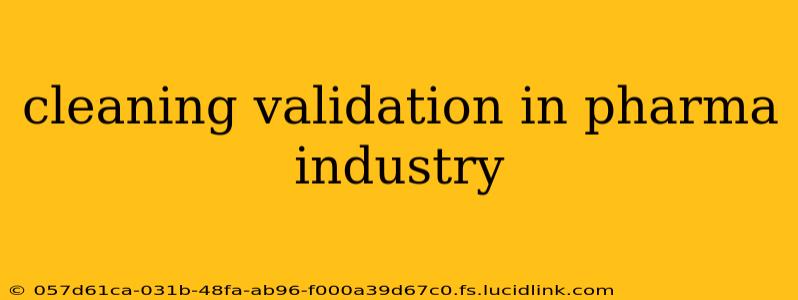The pharmaceutical industry operates under stringent regulations to ensure product quality and patient safety. A critical component of this is cleaning validation, a process designed to demonstrate that cleaning procedures effectively remove residues from equipment and facilities, preventing cross-contamination and ensuring the integrity of subsequent products. This comprehensive guide explores the intricacies of cleaning validation in the pharmaceutical industry, addressing key aspects and frequently asked questions.
What is Cleaning Validation?
Cleaning validation is a documented process used to verify that cleaning procedures consistently remove residues of active pharmaceutical ingredients (APIs), excipients, cleaning agents, and other contaminants from equipment and facilities. This rigorous process is crucial to prevent cross-contamination, which could compromise product quality, efficacy, and patient safety. It's not simply about cleaning; it's about providing documented evidence that the cleaning process reliably achieves the required level of cleanliness.
Why is Cleaning Validation Important?
The importance of cleaning validation in the pharmaceutical industry cannot be overstated. Failure to adequately validate cleaning procedures can lead to several serious consequences:
- Product Contamination: Residual contaminants from previous batches can compromise the quality and safety of subsequent products. This could lead to product recalls, regulatory action, and potential harm to patients.
- Regulatory Non-Compliance: Regulatory bodies like the FDA (Food and Drug Administration) and EMA (European Medicines Agency) have strict guidelines for cleaning validation. Non-compliance can result in warning letters, import alerts, and even manufacturing shutdowns.
- Reputational Damage: A contamination incident can severely damage a company's reputation, leading to loss of consumer trust and market share.
- Financial Losses: Product recalls, regulatory fines, and legal action can result in significant financial losses.
What are the Key Steps in Cleaning Validation?
The cleaning validation process typically involves several key steps:
-
Defining Cleaning Goals: This involves establishing acceptable limits for residual contaminants on equipment surfaces. These limits are often based on toxicological considerations, carryover limits, and the sensitivity of analytical methods.
-
Developing Cleaning Procedures: Detailed written procedures outlining the steps involved in cleaning equipment and facilities must be developed. This includes specifying cleaning agents, cleaning equipment, and the order of cleaning operations.
-
Sampling and Analysis: Samples are collected from equipment surfaces after cleaning to determine the level of residual contaminants. Appropriate analytical methods, such as HPLC (High-Performance Liquid Chromatography) or microbiological assays, are used to quantify these residues.
-
Validation: The data collected from sampling and analysis is used to demonstrate that the cleaning procedures consistently meet the predefined cleaning goals. Statistical methods are often employed to evaluate the data and ensure the robustness of the cleaning process.
-
Documentation: A comprehensive documentation package is essential, including cleaning procedures, sampling plans, analytical results, and validation reports. This documentation provides evidence that the cleaning process meets regulatory requirements.
What are the Different Cleaning Validation Approaches?
Several approaches can be used for cleaning validation, each with its own strengths and limitations:
-
Worst-Case Approach: This approach focuses on the most challenging cleaning scenario, typically involving the most difficult-to-remove residue from the most challenging-to-clean equipment. This approach aims to ensure that if the cleaning process is effective in the worst-case scenario, it will be effective in all scenarios.
-
Attribute Sampling: This approach involves visually inspecting equipment surfaces for visible residue after cleaning. While simpler and less expensive than analytical methods, it's less precise and may not detect low levels of contamination.
-
Probability Sampling: This approach uses statistical methods to determine the optimal number and location of samples to be taken. It aims to represent the entire population of surfaces effectively.
How Often Should Cleaning Validation be Performed?
The frequency of cleaning validation depends on several factors, including the type of product manufactured, the cleaning procedures, and regulatory requirements. Re-validation may be required following changes to cleaning procedures, equipment, or formulations. Regular monitoring and periodic re-validation are critical to ensuring ongoing compliance.
What are the Challenges in Cleaning Validation?
Cleaning validation can present several challenges, including:
-
Developing Sensitive Analytical Methods: Quantifying low levels of residues can be difficult, requiring sensitive and specific analytical methods.
-
Sampling Challenges: Obtaining representative samples from equipment surfaces can be challenging, particularly for complex equipment.
-
Cost and Time: Cleaning validation can be a time-consuming and expensive process.
Conclusion
Cleaning validation is a critical aspect of pharmaceutical manufacturing, ensuring product quality and patient safety. By adhering to strict guidelines and employing robust validation strategies, pharmaceutical companies can minimize the risk of contamination and maintain regulatory compliance. A well-planned and executed cleaning validation program is essential for ensuring the integrity and safety of pharmaceutical products.
